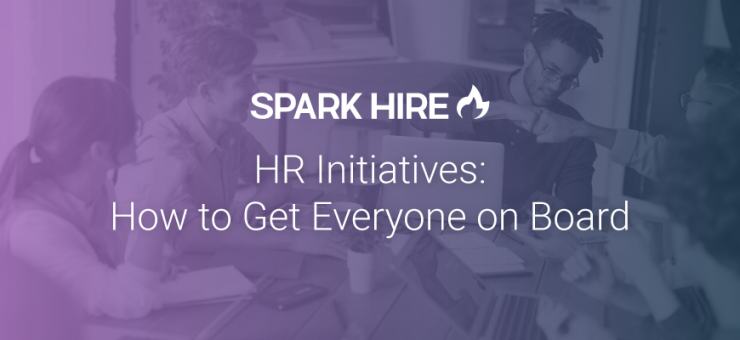As an HR professional, you know your company’s employees and processes like the back of your hand. You’ve likely brainstormed many HR initiatives to improve processes, foster a more welcoming company culture, and overall, develop a greater ROI for the business.
But the disappointment of getting your ideas shot down is a sting that is hard to forget. Do your previous failed attempts at getting the executive team to back up your initiatives stop you from proposing new ones?
While there are many factors that play into your executives’ lack of support, it is worthwhile to consider that your success rate may change if you found a better way to present your initiatives. Executives are looking for the ROI of any investment in ongoing or future HR initiatives, but it may be difficult for them to recognize the ROI. That’s where you come in.
Here are the three key ways you can win over the trust of your executive team when it comes to your HR initiatives:
1. Provide research backing your initiative
Many decisions executives make are data-driven. They want to see research and proof that your proposed initiative will result in achieving better outcomes such as increased value and production within the company.
Let’s explore two examples of how you can provide that research to support HR initiatives.
Example – Employee Pay Increase Initiative
You have noticed that recruiting top talent for certain positions within your company has become more difficult due to the talents’ increased salary expectations. When you have managed to find and hire a skilled candidate, they do not stick around long. Even after accepting the position with your team, they’re receiving higher salary offers from other companies.
To combat this problem, you would like to implement a pay increase for employees within the company. You know it would help the company remain competitive and continue recruiting and retaining better talent. However, simply suggesting to leadership that they should increase employee salaries will not be enough for you to get the necessary support behind this initiative.
In this situation, you would need to conduct your own research beforehand, looking at the salary rates other companies are offering to talent for similar positions. There are many ways to find this information, your professional network is a great starting point.
If you have friends who are in HR, ask them what they typically see in salary rates for certain positions. You can also take advantage of the HR membership groups you belong to. Those groups exist so professionals can support each other with insight. So don’t be afraid to ask for it.
Remember, your HR connections will likely sympathize with you if they understand the situation. Don’t hesitate to explain that you are striving to implement a new change in employee salary to retain better talent and that you need data to get executives on your side. Many of your HR connections are facing or have faced the same difficulty with executives.
Once you have gathered your data on what other companies are paying employees, your next step is to begin creating your presentation.
Creating your presentation
Step 1:
Discuss your observations and feedback from new hires who are leaving. Chart or graph this feedback and the number of new hires leaving so that your executive team can clearly see the effect on turnover.
Step 2:
Next, include your data comparison of salary rates within other companies. Build this information into a chart or graph as well. It will be a great visual guide for the executive team to see how much salaries differ between their company and others.
Step 3:
Then, display the benefits of offering more competitive salaries. Discuss how it affects the company’s hiring and turnover rates, and, by extension, saves on recruiting/hiring time and money.
If you don’t already have an idea of the company’s cost per hire, here’s how you can calculate it:
Take the average time you require to recruit for a position and multiply that by your approximate hourly rate and additional costs of recruiting tools. Then, add in the total cost of a new hire. That includes the cost of background checks, drug testing, assessments, orientation, etc.
Your company’s leadership will have a stronger inclination to lower turnover rates if they recognize how much it is costing them.
Step 4:
To close, summarize that offering more competitive salaries will allow the company to recruit and retain top talent. And, overall, that would result in a better quality of work from employees.
2. Show data from your previous HR initiatives
If you’ve been in HR for some time, then it’s likely you have already implemented successful initiatives. Perhaps your existing initiative is a tag-on to a previous one that has been implemented already.
In this case, you want to present the data from the previous initiative, showing how effective it was and explaining how further improvements can make it even better. Ideally, you would have tracked the results of the initiative, and you already have the data you need. If not, try to look back and find those numbers that prove your point.
Let’s review an example of how you could use data from one of your previous initiatives to back an existing initiative you would like to present to your executive team.
Example – Flexible Hours as Part 2 of an Existing Hybrid Working Initiative
Perhaps you have already convinced decision-makers at your company to implement a hybrid working modality. Since the team missed being in the office, they now have days of the week they can choose to work in-person.
The intention of this change was to keep staff motivated, as many began to dread working from home. In turn, it also helped out retention.
However, maybe you’re finding now that it isn’t enough. Many team members aren’t getting enough sleep or mentally checking out of work. And those who balance parenting or caregiver duties are still very drained.
Naturally, you want them to have the control they need to make it the best possible work experience. But decision-makers won’t necessarily support an initiative to help employees if they don’t clearly see how it can help the company in the long run.
Before you approach your executives with your initiative to completely reorganize how employees work (again), you need to have data backing you up.
Creating your presentation
Step 1:
Begin your presentation by going through the data and results of your first non-traditional working initiative. If you do not already have data on the initiative, go back through the company’s numbers from the past year to note changes in productivity since implementing the change.
As mentioned in the previous example, it is most useful to present the data visually. Having comparison charts that demonstrate productivity and profit when all employees worked in the office, when all worked from home, and when they were given the choice on where they wanted to work throughout the week.
Step 2:
Follow up with data on what kinds of companies have switched to flexible hours and how well it has worked for them. This will help the executive team see that flexible hours aren’t as unusual as it may seem at first.
Then, go into the details of your solution. While it’s helpful to see that other businesses have succeeded with this model, executives are unlikely to agree unless they understand how it would specifically impact your workforce and culture.
Step 3:
As you introduce your solution, keep the presentation focused on a core message. This makes it easy for decision-makers to follow your reasoning regarding why this new initiative would work. Drive home that the hybrid modality has worked well because the team knows themselves and how they work best. And the same will apply to allowing them to choose their own hours.
In other words, “Initiative A worked because of x. Because of x, Initiative B will also be effective.”
3. Get your executives engaged
Most individuals in leadership are data-driven. As we’ve already explained, numbers play a huge role in guiding their decision-making. But they’re still human.
A bland presentation that strictly addresses data isn’t engaging. Executives, just like anyone else, become more invested in ideas that appeal to their emotions. The key to getting support for HR initiatives is to pull in clear data, real-life scenarios, employee accounts, and a thought-out plan of action.
Example – Virtual Happy Hour Initiative
Although the team is settling into the routine of hybrid or remote work, you’re still noticing discontent regarding collaboration and connection. Communicating in team meetings or chat can only go so far to cure isolation and cabin fever.
The obvious answer is a virtual happy hour, but you know it hasn’t worked well for everybody. So instead of forcing your team into unwanted small talk, you want to provide the opportunity for everyone to have some fun. By playing online games together, the team can release tension and build comradery.
Simply telling company executives you think everyone would benefit from playing games together online may solicit strange looks. But here’s how you can build up to implementing a strategy for fun in your presentation and get them genuinely excited by the HR initiatives:
Step 1:
Find the commonalities between the executive and employee experience. Whether they be in a leadership or an entry-level position, everyone at your company has likely suffered from Zoom fatigue. So suggesting more virtual time right off the bat probably isn’t a great idea.
Instead, appeal to the near-universal frustration of attending too many meetings, the loneliness everyone feels when working from home for too long without enough social interaction, and how exhausting it can be to handle heaviness so often. Tapping into those emotional experiences will give leadership a sense of relief when you offer a solution that encourages fun.
Step 2:
Pull in feedback from current employees to show that this initiative is relevant to the needs of the group.
Powerful quotes are a great way to pack an emotional punch. They show the executives exactly what employees are feeling and how it impacts their work.
If you have recent survey results revealing how your team is feeling about employee engagement, reference that data too. A graph showing that feedback would be visually appealing, data-focused, and centered around the emotional status of remote employees.
Step 3:
Take a look at the list of companies that were voted best employers and look into what they’ve done to keep everyone connected. Your executives should be aware of the significance of company culture and employee engagement. Pointing out how you can all learn from the companies doing the best at it (their award-winning ideas and their mistakes) is sure to win over support for your HR initiatives.
This post was originally submitted by a regular contributor and was updated in Feb 2021.












